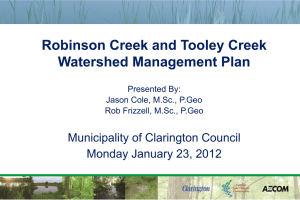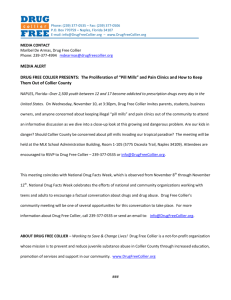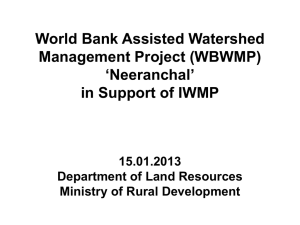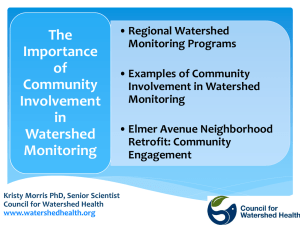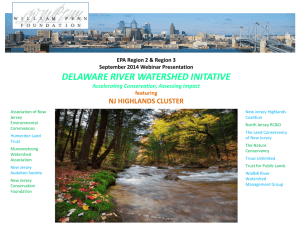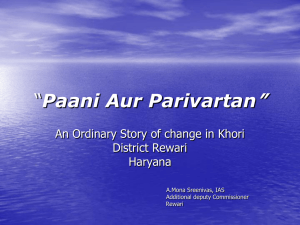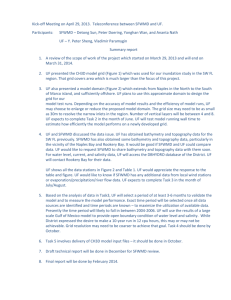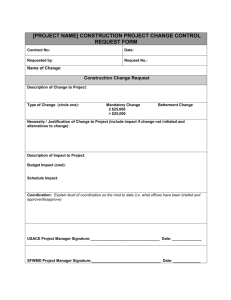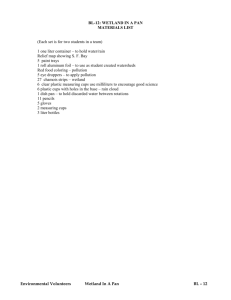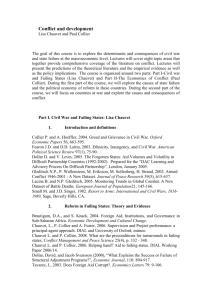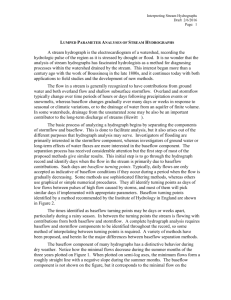Watershed Management Plans for Collier County
advertisement
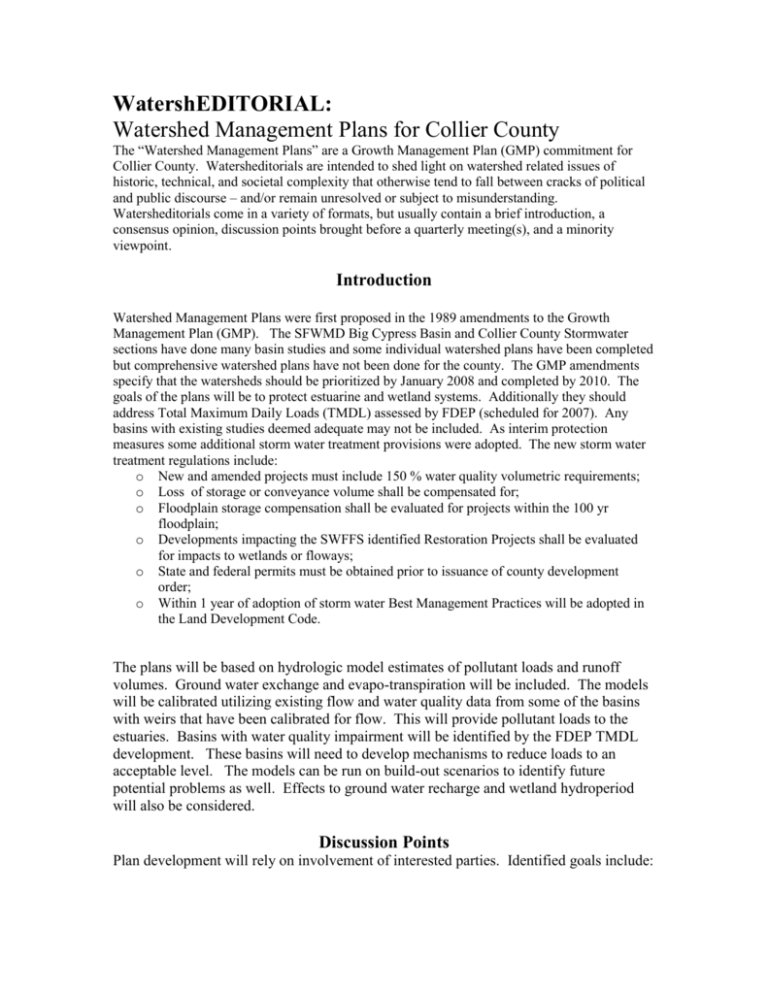
WatershEDITORIAL: Watershed Management Plans for Collier County The “Watershed Management Plans” are a Growth Management Plan (GMP) commitment for Collier County. Watersheditorials are intended to shed light on watershed related issues of historic, technical, and societal complexity that otherwise tend to fall between cracks of political and public discourse – and/or remain unresolved or subject to misunderstanding. Watersheditorials come in a variety of formats, but usually contain a brief introduction, a consensus opinion, discussion points brought before a quarterly meeting(s), and a minority viewpoint. Introduction Watershed Management Plans were first proposed in the 1989 amendments to the Growth Management Plan (GMP). The SFWMD Big Cypress Basin and Collier County Stormwater sections have done many basin studies and some individual watershed plans have been completed but comprehensive watershed plans have not been done for the county. The GMP amendments specify that the watersheds should be prioritized by January 2008 and completed by 2010. The goals of the plans will be to protect estuarine and wetland systems. Additionally they should address Total Maximum Daily Loads (TMDL) assessed by FDEP (scheduled for 2007). Any basins with existing studies deemed adequate may not be included. As interim protection measures some additional storm water treatment provisions were adopted. The new storm water treatment regulations include: o New and amended projects must include 150 % water quality volumetric requirements; o Loss of storage or conveyance volume shall be compensated for; o Floodplain storage compensation shall be evaluated for projects within the 100 yr floodplain; o Developments impacting the SWFFS identified Restoration Projects shall be evaluated for impacts to wetlands or floways; o State and federal permits must be obtained prior to issuance of county development order; o Within 1 year of adoption of storm water Best Management Practices will be adopted in the Land Development Code. The plans will be based on hydrologic model estimates of pollutant loads and runoff volumes. Ground water exchange and evapo-transpiration will be included. The models will be calibrated utilizing existing flow and water quality data from some of the basins with weirs that have been calibrated for flow. This will provide pollutant loads to the estuaries. Basins with water quality impairment will be identified by the FDEP TMDL development. These basins will need to develop mechanisms to reduce loads to an acceptable level. The models can be run on build-out scenarios to identify future potential problems as well. Effects to ground water recharge and wetland hydroperiod will also be considered. Discussion Points Plan development will rely on involvement of interested parties. Identified goals include: o Prioritize Watersheds based on greatest growth potential, wetlands, and listed species habitat; o Address Federal and State agency plans for Total Maximum Daily Loads (TMDLs); o Conservation of appropriate upland and wetland buffers to wetlands; o Minimize adverse effects of fresh water discharges on wetlands and the estuarine systems; o Maximize ground water recharge of runoff; o Limit effects of salt water intrusion; o Minimize the adverse effects of timing and flow of fresh water to the estuaries; o Balance needs of watershed natural resources and human population; o Conserve natural features of the floodplain so they will continue to provide natural beneficial functions; o Non-structural methods of water management will be considered first for proposed water management works; o Wetland and estuarine habitat functions will be conserved or enhanced; and o Wetland and estuarine conservation shall be accomplished using incentives, land acquisition, conservation easements, and transfer of development rights. We have identified 3 advisory teams and will have meetings and workshops periodically through the plan development: o Project Delivery Team – Key Departments and the SFWMD Big Cypress Basin that will be responsible for implementation; o Technical Agency Group – Ensure coordination with existing and future agency programs; o Stake holder Group – public, consultants, and advocates; o Collier County Advisory Boards – EAC and CCPC; and o Collier County Board of County Commissioners We have also identified the following on-going efforts that need to be coordinated. o Natural Aquifer Recharge Study - CC Pollution Control Dept.; o NPDES – CC Stormwater; o East of 951 Study – CC Comprehensive Planning; o Southwest Florida Feasibility Study – SFWMD and USACE; o TMDL program – FDEP; o Naples Bay SWMM – SFWMD and City of Naples; and o Nano-wetlands study – CCSWCD Consensus Opinion This will be the first time comprehensive Watershed Management Plans will be developed for multiple watersheds simultaneously in Collier County. Watershed management planning is generally considered an iterative process. Development of the plans will likely identify areas that need additional monitoring. Continued monitoring will determine the success of the alterations and provide the basis for future reevaluation. Stormwater runoff has high nutrient (nitrogen and phosphorus) concentrations. Nutrient loading limits are not clearly established. They must be evaluated by analyzing dissolved oxygen and or chlorophyll a or both. Dissolved oxygen concentrations are strongly affected by temperature and community metabolism, especially plants. Manmade alterations such as dredging and channeling fresh water flows to estuaries often contributes to lowered oxygen concentrations. Dissolved oxygen impairments that can’t be attributed to a causative agent are not required to develop TMDLs. Nutrient enrichment is clearly linked to increased plant growth. Connections to some nuisance algae i.e. drift algae, red tide, and Trichodesmium blooms are not well established. Impacts of very large freshwater discharges to Naples Bay and Faka Union Bays have been identified. The SWFFS will be identifying some water quality targets for these and all of the coastal bays. However, we know very little about the tidal exchange dynamics or effects on most of the estuaries. Rookery Bay and the Naples Bay SWIM plan will be studying these issues during the development of the plans. Ground water recharge information will be used to evaluate the need for regulating land use based on recharge needs. Minority Opinion Since these plans have not been developed there has not been much public debate. The following points are included as a point of debate initiation. Dissolved oxygen impairments without link causative parameter will require corrective actions to be developed and implemented. Nutrient increases that don’t cause impairments will require corrective actions to be developed and implemented.


